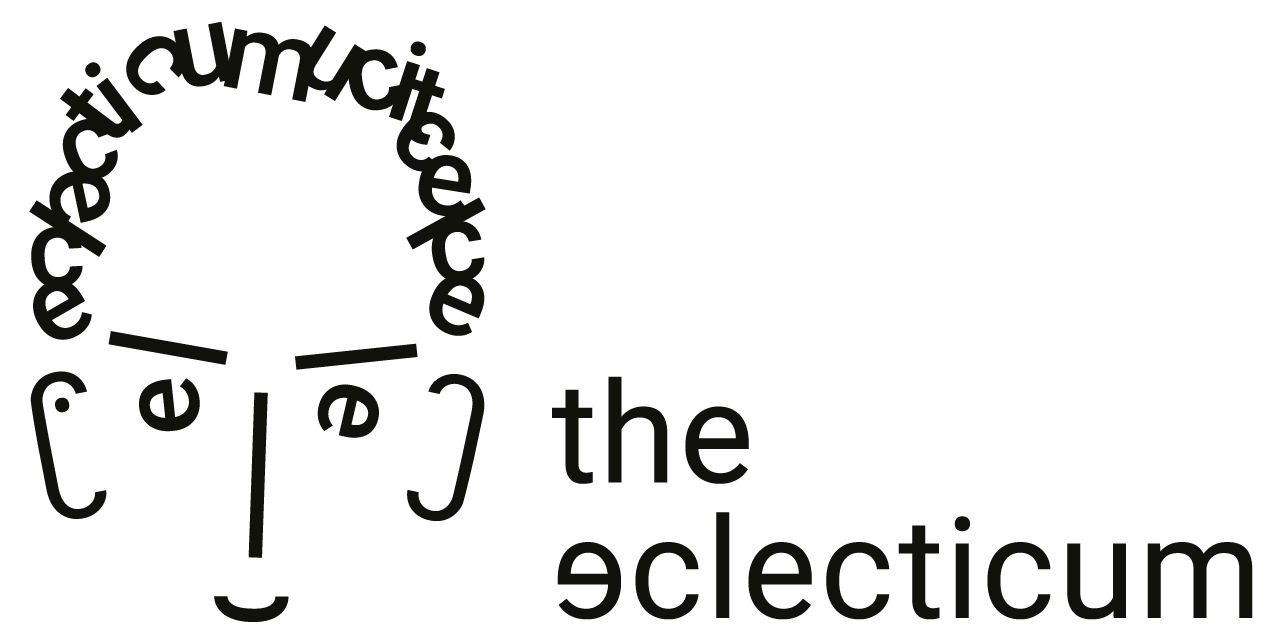written by:
Ornatus Mundi
published:
2023-07-23
categories:
analysis, Novelty 2021, Vianney Halter, watches, watchmakers
Vianney Halter’s Deep Space Tourbillon Resonance: a temperamental astronomical loupe (without any such indication!)
The Vianney Halter Deep Space Tourbillon Resonance teaches us about resonance as a fundamental phenomenon shaping a self-organising Universe
That Vianney Halter is anything but just a (very good) watchmaker is legend. His timepieces are a distillation of so many of his interests and inspirations, primarily the works of path making watchmakers such as Antide Janvier or Abraham Louis Breguet, but also aviation, music and a lot of other sources.
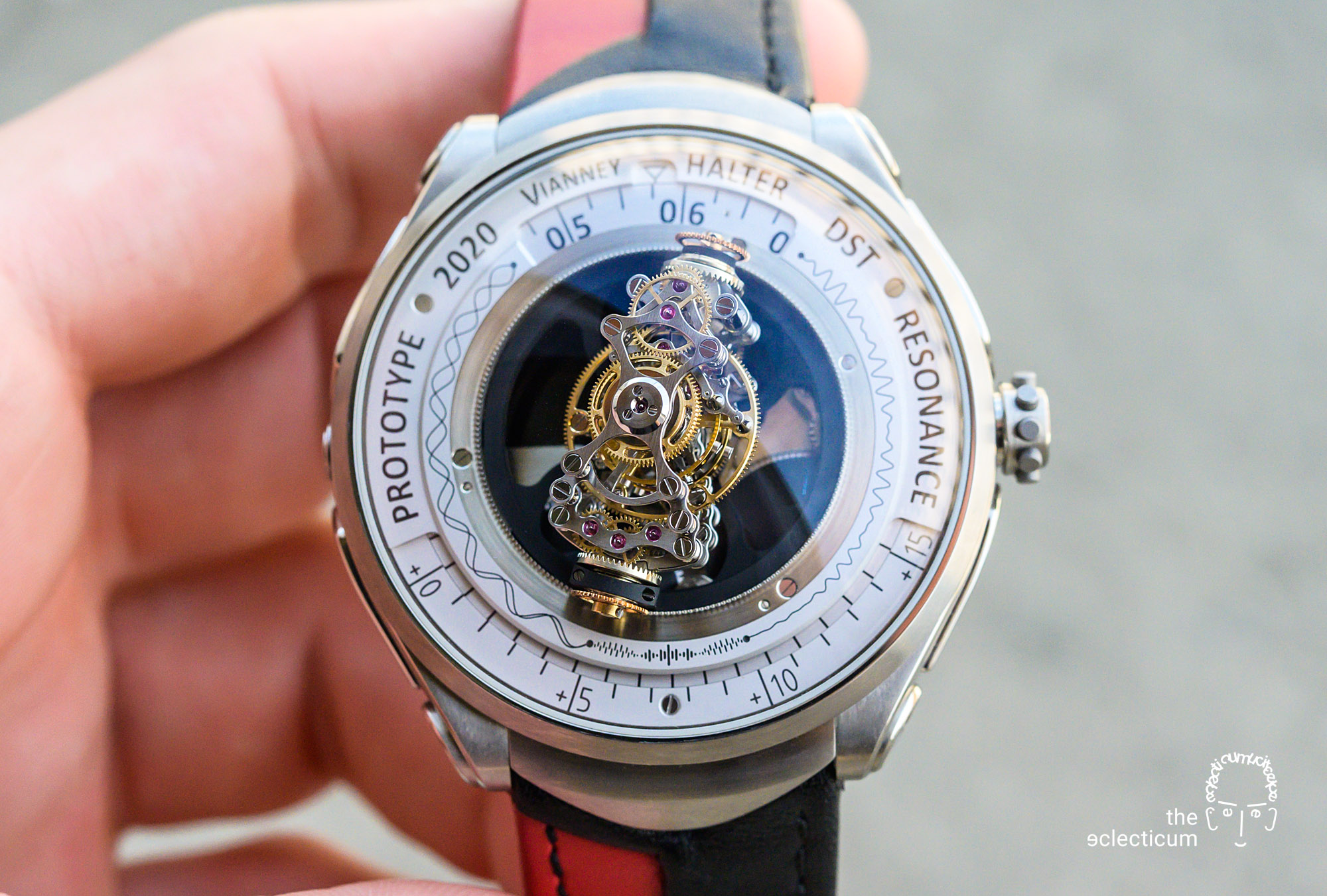
This time however, he has outdone himself: Vianney Halter’s new Deep Space Tourbillon Resonance shifts his whole watchmaking work onto a whole new orbit: it is the result of more than two decades of observation, experimentation and studying, and a timekeeper (in the best sense of the word) which does not only excel at that, but manages to embrace physical phenomena of our Universe and condense them to wrist-size, in ways most mesmerising and entertaining.
But first, what is it?
The Deep Space Tourbillon Resonance is – as the name already hints – a tourbillon which makes use of the physical phenomenon of resonance (in fact, reflective resonance to be precise, as I shall outline in my side note further down). But not only that, Halter managed to realise this in a triple-axis tourbillon – a mind-boggling feat:
- 3-axis tourbillon
- 2 oscillators (nominally 21‘600 vph)
- acoustic coupling

The axis structure is layered in concentric cages:
- The innermost cage holds the balances and weighs 0.6 grams for 162 parts. This cage rotates inside the traverse in 60 seconds.
- The traverse weighs 2.8 grams and rotates around its horizontal axis in 6 minutes.
- The traverse is mounted in the cradle, that rotates on its vertical axis in 30 minutes.
The whole 3-axis system counts 371 individual parts, amongst which are 42 polished curved pillars that connect the bridges:
 (Image © Guy Lucas de Peslouan)
(Image © Guy Lucas de Peslouan)
For this prototype, the dial was developed as a no-nonsense tool, and directly inspired by the Vernier calliper. The hours and quarters can be read in the top aperture.

At the bottom aperture one can read the supplemental minutes past the last quarter by finding where the marks match the best.
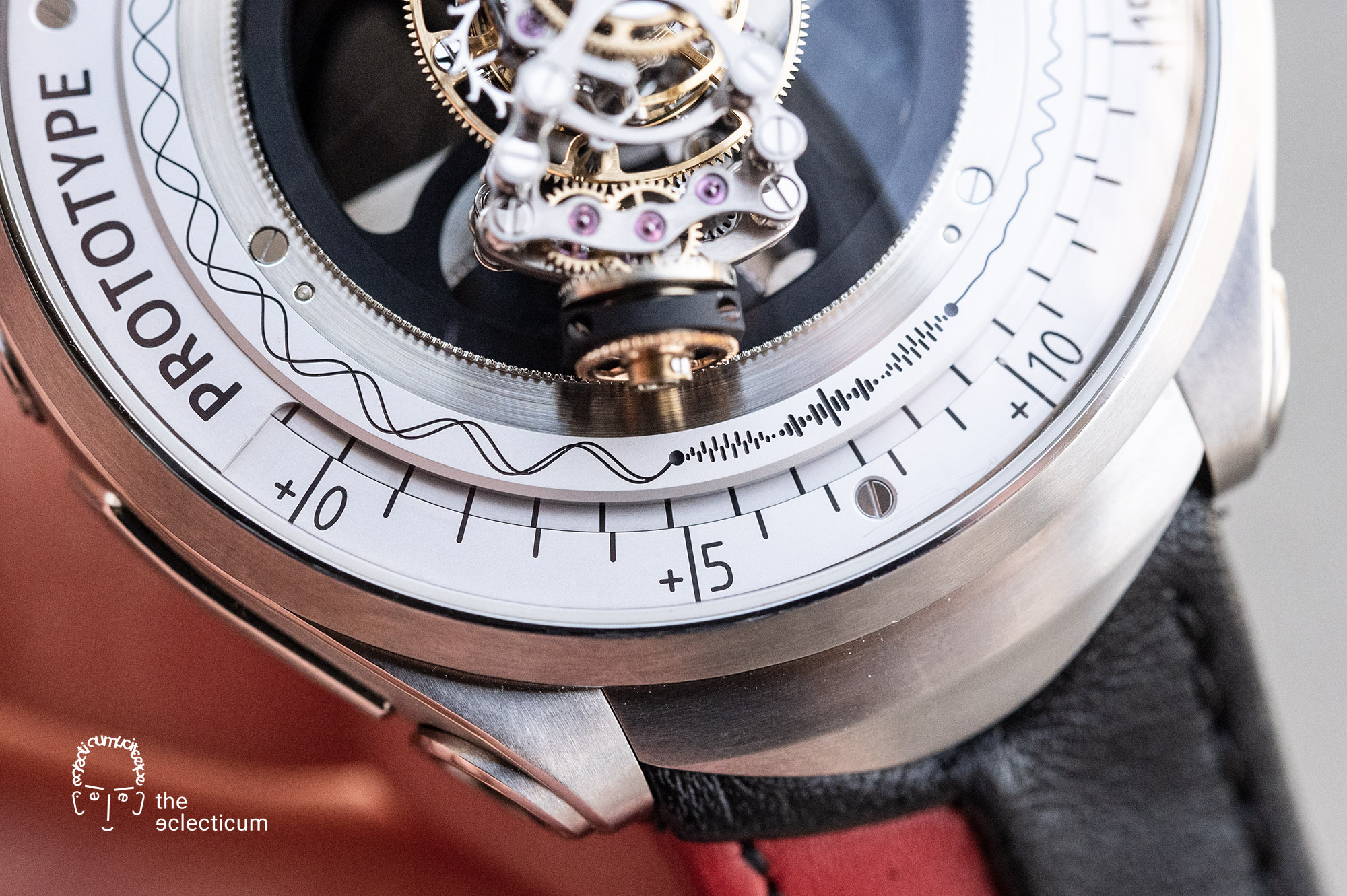
In the images shown here the time is 05.48 h.
Of course, this is a prototype only, and a few improvements are still on the way to production status: a more legible dial, better power reserve (currently 65h), and else.
It took Vianney Halter more than two decades to arrive here, what has begun in the mid-1990s when he learnt piano and observed that when he hit the keys with three harmonic strings overlap, an energy exchange between the strings occurred that forced them to resonate, made possible through the solid piano frame which connected them – similar also to a tuning fork. This is what is called reflective resonance.
Side note: reflective resonance – this is the physical phenomenon which is primarily in action here and which is most commonly mixed up with simple ‘resonance’. So, let’s go down on this. Please note: I am not attempting to present a comprehensive breakdown of the physical theory and its implications in watchmaking here, others have done this far better and more extensively than I could, hence I am referring to a few articles well worth your time (*).
Resonance is the base phenomenon one needs to consider when discussing oscillating systems like escapements, be it mechanical or quartz ones. Oscillating systems describe wave vibrations in sinus form, with top and bottom peaks, which is where their maximum potential energy stats lay, and the centre of the wave, where the maximum kinetic energy is achieved. The delta between the two peaks is called the amplitude (which in a watch escapement is measured by as degrees of an angle).
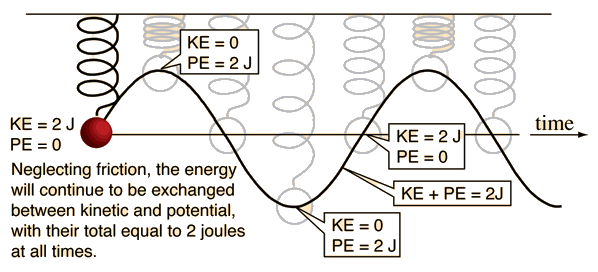
(Energy transformation between potential energy (PE) and kinetic energy (KE) of an oscillating system. Source: R. Nave, Georgia State University, Hyperphysics Lab. http://hyperphysics.phy-astr.gsu.edu/hbase/shm2.html#c4)
Resonance refers to the interaction of two waves, where the first one gets ‘in phase’, i.e., with the same frequency, impulses from an external‘ vibrating force. Examples are a child’s swing which gets pushed by their parent, or an oscillating pendulum or balance spring which receive impulses from the pallet’s impulse jewel. The systems then swing in their ‘designed’ frequency, the resonant frequency (for a child’s swing the word ‘designed’ is difficult to imagine, but the resonant frequency is defined by stiffness of the pendulum (swing ropes) and its mass. You get the idea that you can’t push for faster swings without compromising your kid’s safety…). For maximum effect the impulse needs to hit when the oscillator is at its maximum potential energy state, which is at its extremes of its oscillation, for it to realise high kinetic energy.
Reflective resonance: let’s imagine we add a second, separate mechanical oscillator which has the same resonant frequency. If close enough to each other and further energetically coupled, somehow at least, the two oscillating systems begin to interact, exchange energy and influence each other in a way physicists call wave reflection. At the peaks of their waves (KE = 0), oscillators stop before they continue with the next swing in the opposite direction. At this point, they transmit a tiny amount of energy to the structures supporting them (i.e., a balance cock). It is this tiny amount of energy, a vibrational wave, that is picked up by the fellow coupled oscillator and results in small incremental changes in the oscillation curve and the amplitude, resulting in the two oscillating systems to sync (either in phase or 180° off phase) with a higher amplitude than if operating alone – the reflective resonance. The mutual correcting influence one system exerts on the other results in a higher consistency of rate of the overall system. Note that if no second oscillating system is present, this energy would dissipate unused.
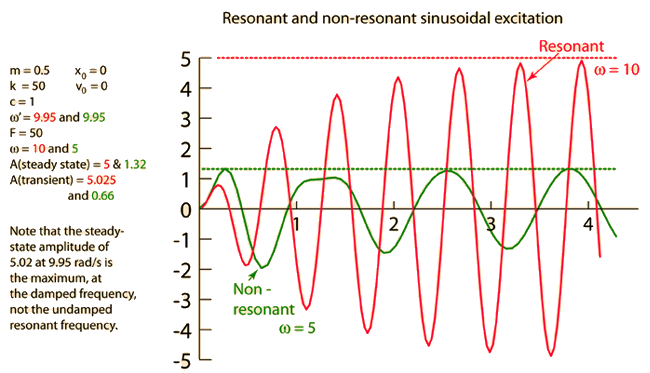
(Reflective resonant oscillating system, note the higher amplitude achieved. Source: R. Nave, Georgia State University, Hyperphysics Lab. http://hyperphysics.phy-astr.gsu.edu/hbase/oscdr2.html)
A few notes:
- For reflective resonance to occur, certain physical parameters, such as the mass ratio between oscillating mass and the watch mechanism, have to be met – I’ll touch this aspect further down again
- The two systems must be closely positioned and regulated to each other (for acoustic coupling such as in F.P. Journe’ watch, the daily rate of the escapements must be within 5sec between them) and require constant power supply
- Higher consistency does not mean higher precision, but higher dependability of the oscillators’ readout
- If no second oscillating system is present, the reflective energy would dissipate unused
This shall suffice to describe the phenomenon of reflective resonance. If you want to learn more, I really encourage you to read the literature* linked at the end of this article.
Reflective resonance as a tool to foster rate consistency in watchmaking is not new, and a number of the greatest scientists and watchmakers have theorised or finally made use of waves reflected between mechanically coupled oscillators to stabilise going rate: Galileo Galilei described a mechanism in principle, but did not live to see it as a mechanism, Christiaan Huygens was the first to observe it, and in hindsight it was an incredible coincidence that he made his discovery: in early 1665, being sick (and probably bored) at home, he had two almost identical pendulum clocks sitting next to each other. He noticed that the two clocks, by coincidence side-by-side and thus mechanically coupled, swung in exactly the same frequency and exactly 180° out of phase. When he disturbed one pendulum, the anti-phase state was restored within half an hour and remained indefinitely. Scientist have only almost four centuries later mathematically proven that the two clocks had actually the exact mass ratio required for reflective resonance to set in. What an incredible stroke of luck!
 (Antide Janvier, Pendulum Regulator with Resonance (1780), exhibited in a private room of F.P. Journe’s Geneva showroom)
(Antide Janvier, Pendulum Regulator with Resonance (1780), exhibited in a private room of F.P. Journe’s Geneva showroom)
Antide Janvier, and particularly Abraham-Louis Breguet experimented extensively on resonance, using different coupling strengths, and also as per George Daniels’ book ‘The Art of Breguet’ (p. 76f.) empirically proved that it is indeed mechanical coupling instead of air friction which enabled resonance.
 (Breguet pocket watch No. 2788 dated 1812, with two resonating, but aerodynamically isolated escapements. The watch was set to be auctioned by Sotheby’s in London on 28 October 2020, Lot #205, but was ultimately withdrawn. Image © Sotheby’s)
(Breguet pocket watch No. 2788 dated 1812, with two resonating, but aerodynamically isolated escapements. The watch was set to be auctioned by Sotheby’s in London on 28 October 2020, Lot #205, but was ultimately withdrawn. Image © Sotheby’s)
Most famous for the use of resonance in watches today is of course François-Paul Journe with his legendary Chronomètre à Résonance (weak acoustical coupling through mainplate, similar to Breguet, see also https://www.theeclecticum.com/f-p-journe-20th-anniversary-exhibition-20-years-chronometre-a-resonance/) on the one hand, and Beat Haldimann, Armin Strom or Donald Corson (rigid mechanical coupling of balances through a carefully dimensioned and shaped coupling spring).
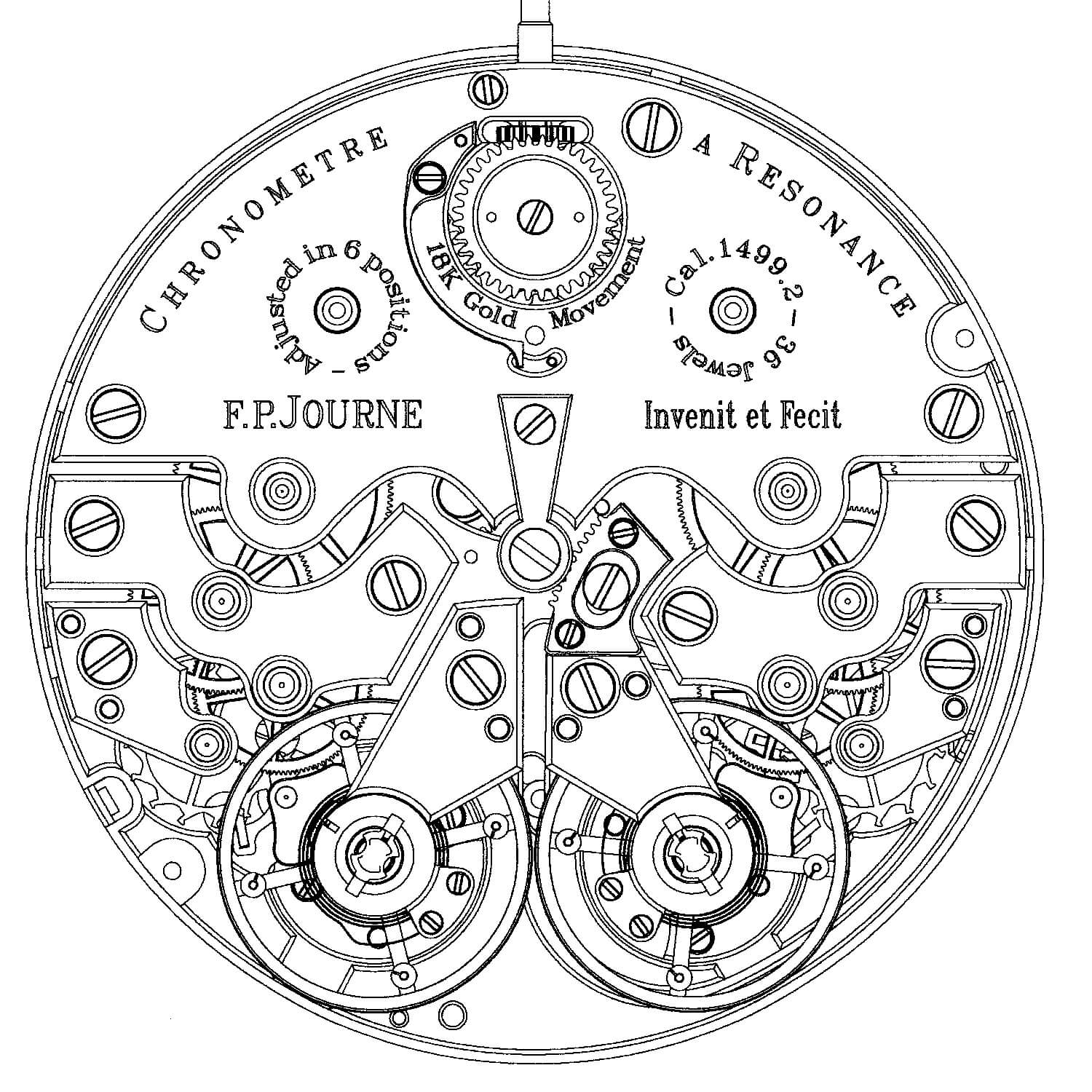
(F.P. Journe Chronomètre à Résonance Cal. 1499.2 – note the adjustment snail on the right escapement system which fine-tunes the distance between the two. Image © F.P. Journe)

(Armin Strom Mirrored Force Resonance concept. Image © Armin Strom)
Vianney Halter exploits the phenomenon in quite a different way, as we will see!
A resonator with its own will and personality:
The first striking difference between above resonance-enabled watches is the relative positioning of the oscillators: while Breguet, Journe as well as Armin Strom or Don Corson placed their balances adjacent to each other on the movement’s plate, Vianney Halter put them, in principle like Beat Haldimann did, (i) into one common tourbillon cage (Haldimann’s resonance tourbillon) and (ii) on the same axis (the pendulums in Haldimann’s resonance clock). However, in contrast to the former, there is no strong mechanical coupling of balances via a dedicated spring:
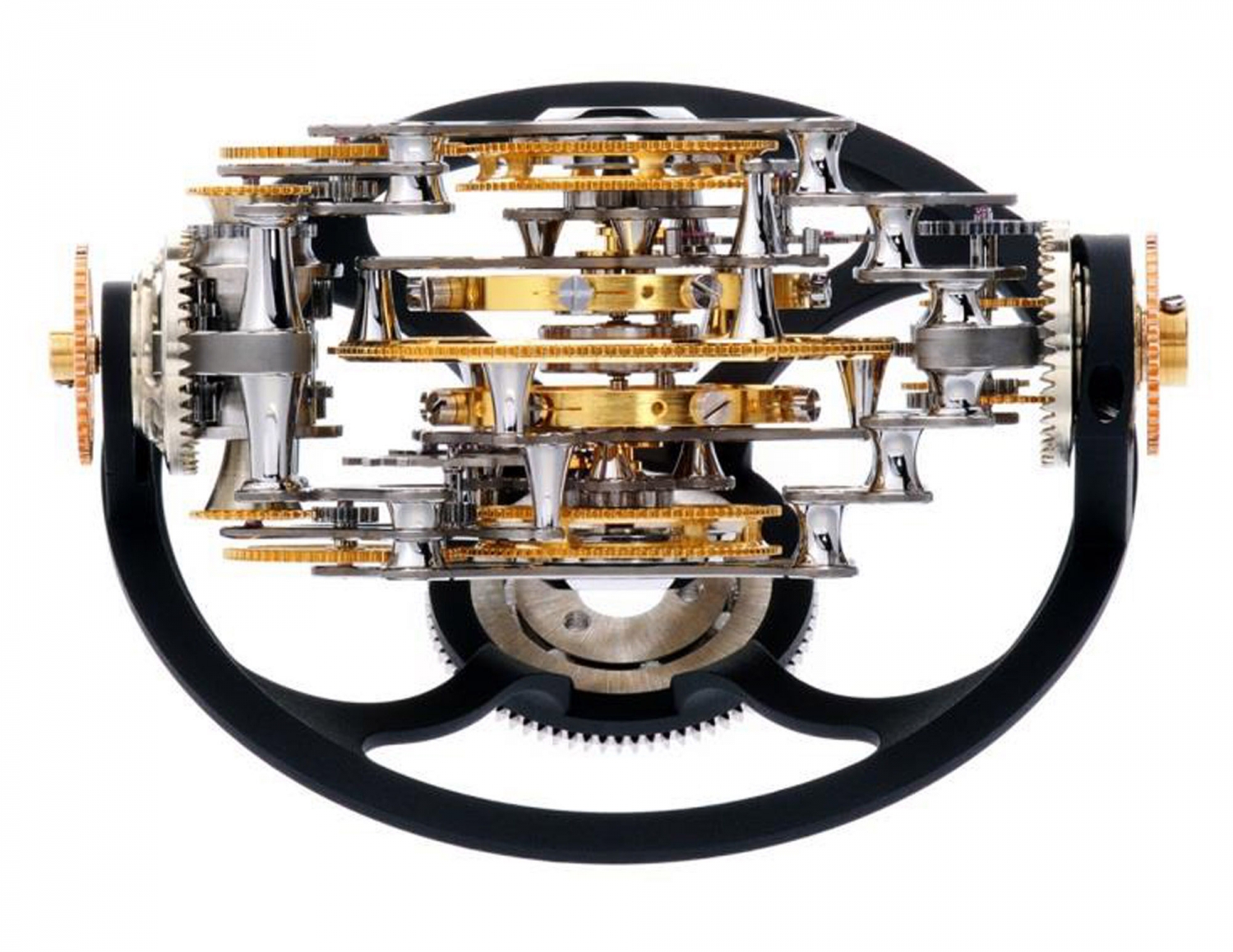 (Image © Guy Lucas de Peslouan)
(Image © Guy Lucas de Peslouan)
This means that Vianney’s coupling works acoustically as Journe’s. He experimented with suitable, rigid materials for the connecting bridge in order to minimise wave dissipation between the oscillators. The arrangement has been carefully tuned and optimised, and shows a fascinating behaviour: as I noted already above, the frequency is ‘nominally’ 21‘600 vph – and there is a reason for that:
The two oscillators mutually influence each other until their ‘agree’ on a common frequency, but this frequency is not always the same value, and also the relative direction (in phase or not; the latter would according to John Davis not be possible with strong mechanical coupling) is different after each fresh start of the watch. Talk about personality!
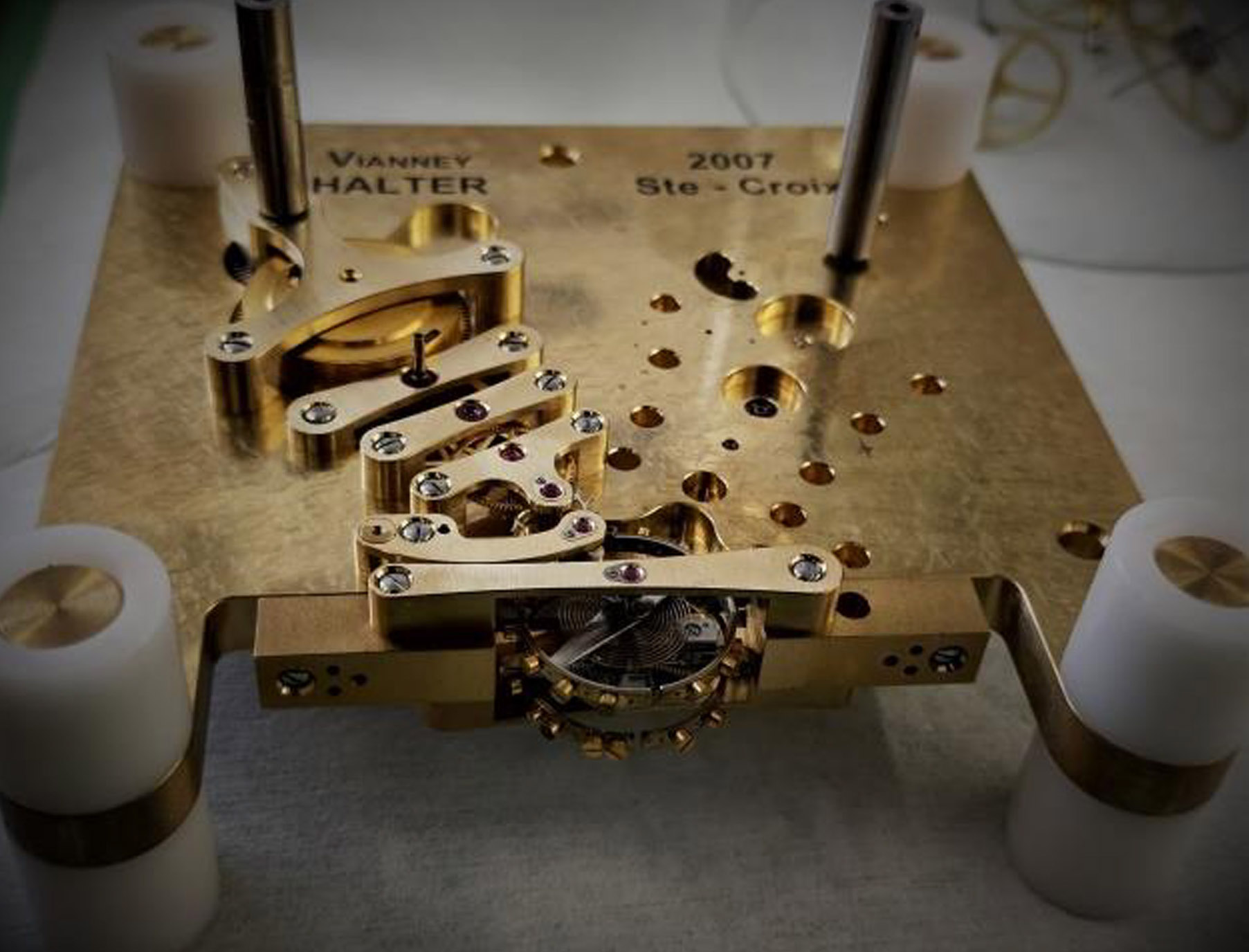 (Vianney’s resonance demonstrator platform using two identical going trains of Russian deck watches. Image © Guy Lucas de Peslouan)
(Vianney’s resonance demonstrator platform using two identical going trains of Russian deck watches. Image © Guy Lucas de Peslouan)
The arrangement is delicate and requires very careful adjustment and poising of the entire mechanism.
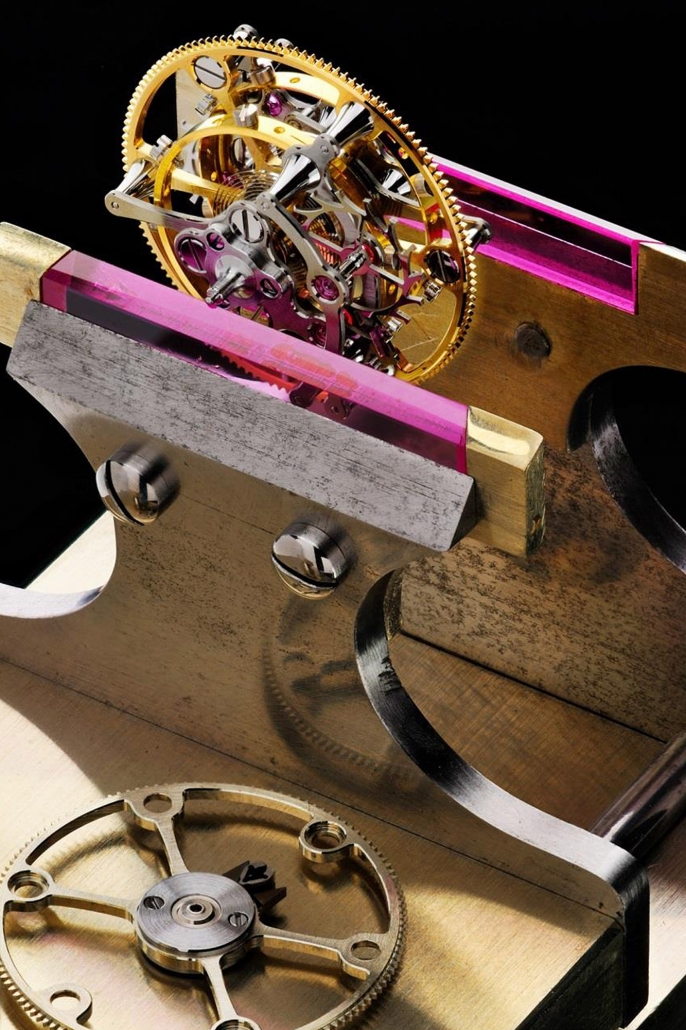 (Image © Guy Lucas de Peslouan)
(Image © Guy Lucas de Peslouan)
That the finishing is of exquisite quality is not a surprise, but the finely mirror-polished curved pillars of the cage (there are 42 of those beauties!) is really something to appreciate!
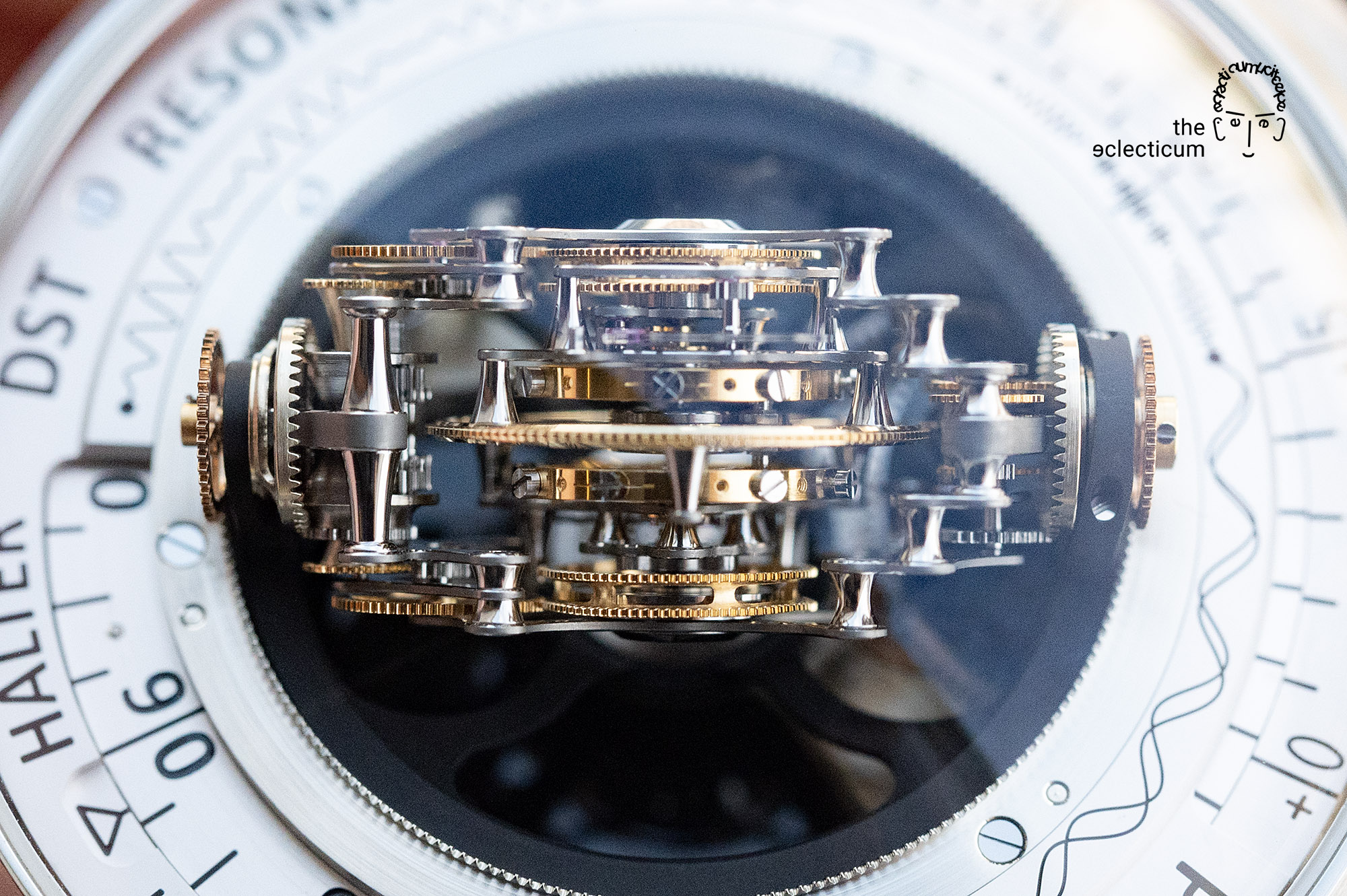

The Deep Space Tourbillon Resonance as a model for a self-organising Universe:
Imagine there is a mutual influence and shaping of relative positioning and directions, a phenomenon intended by Vianney after he digested the sensational 2016 discovery of gravitational waves (see: Abbott PA et al. (2016): Observation of Gravitational Waves from a Binary Black Hole Merger. Phys. Rev. Lett. 116, 061102) which proved Albert Einstein’s theory of relativity, and the space time continuum:
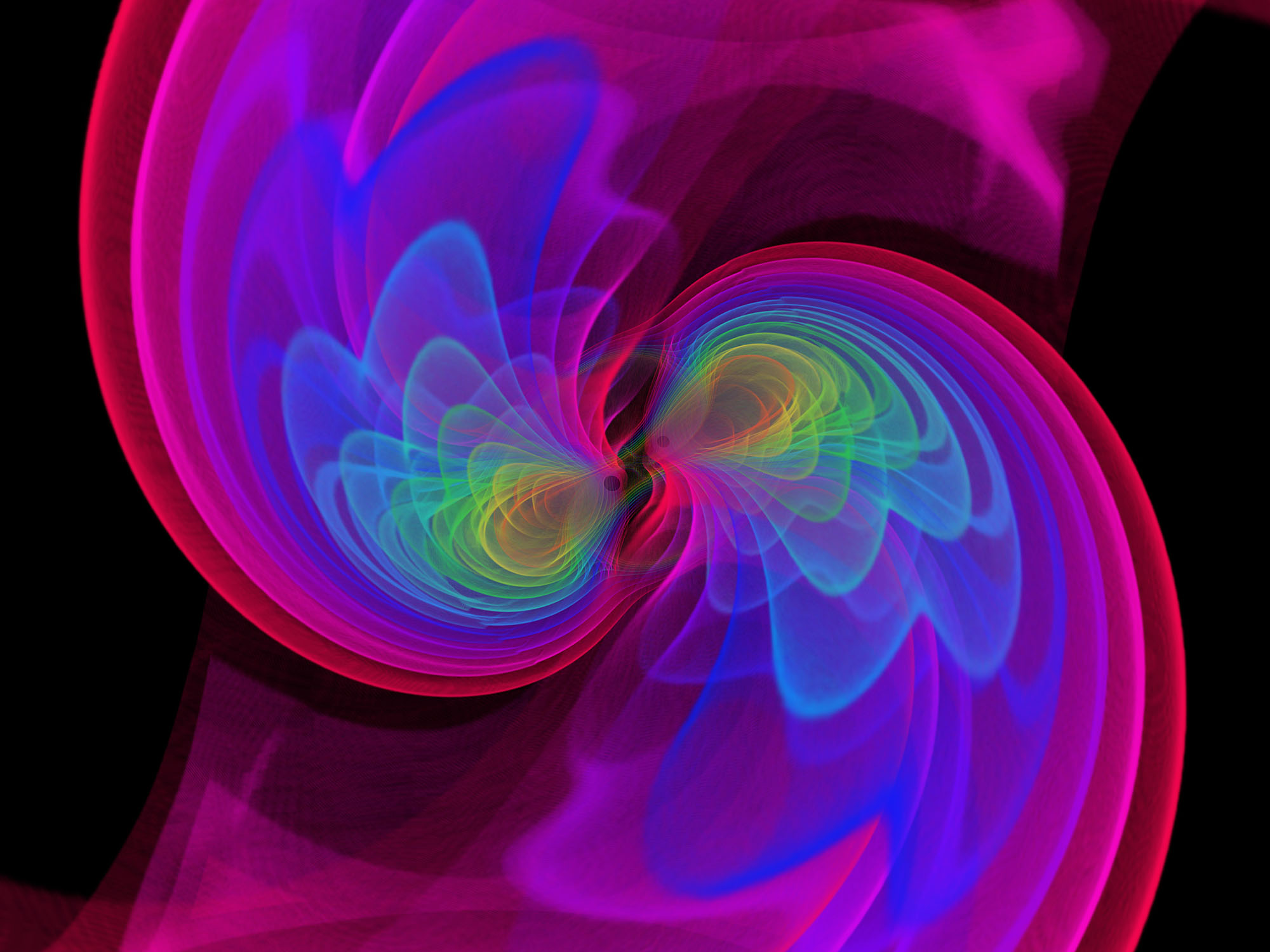 (Two collapsing black holes and the resulting gravitational waves. Image © Max Planck Institute of Gravitational Physics)
(Two collapsing black holes and the resulting gravitational waves. Image © Max Planck Institute of Gravitational Physics)
It has recently been discovered that gravitational waves can resonate, thereby (theoretically) being able to acquire sufficient energy to efficiently catapult particles with significant implications in astrophysics (see: Asenjo FA and Swadesh M. Mahajan SM (2020): Resonant interaction between dispersive gravitational waves and scalar massive particles. Phys. Rev. D 101, 063010). The consequence of this is that the interaction of masses and their respective waves in the universe shapes the universe itself.
To understand why this is so important for the watch, let’s go back to Vianney Halter’s first Deep Space watch, the Deep Space Tourbillon of 2013:
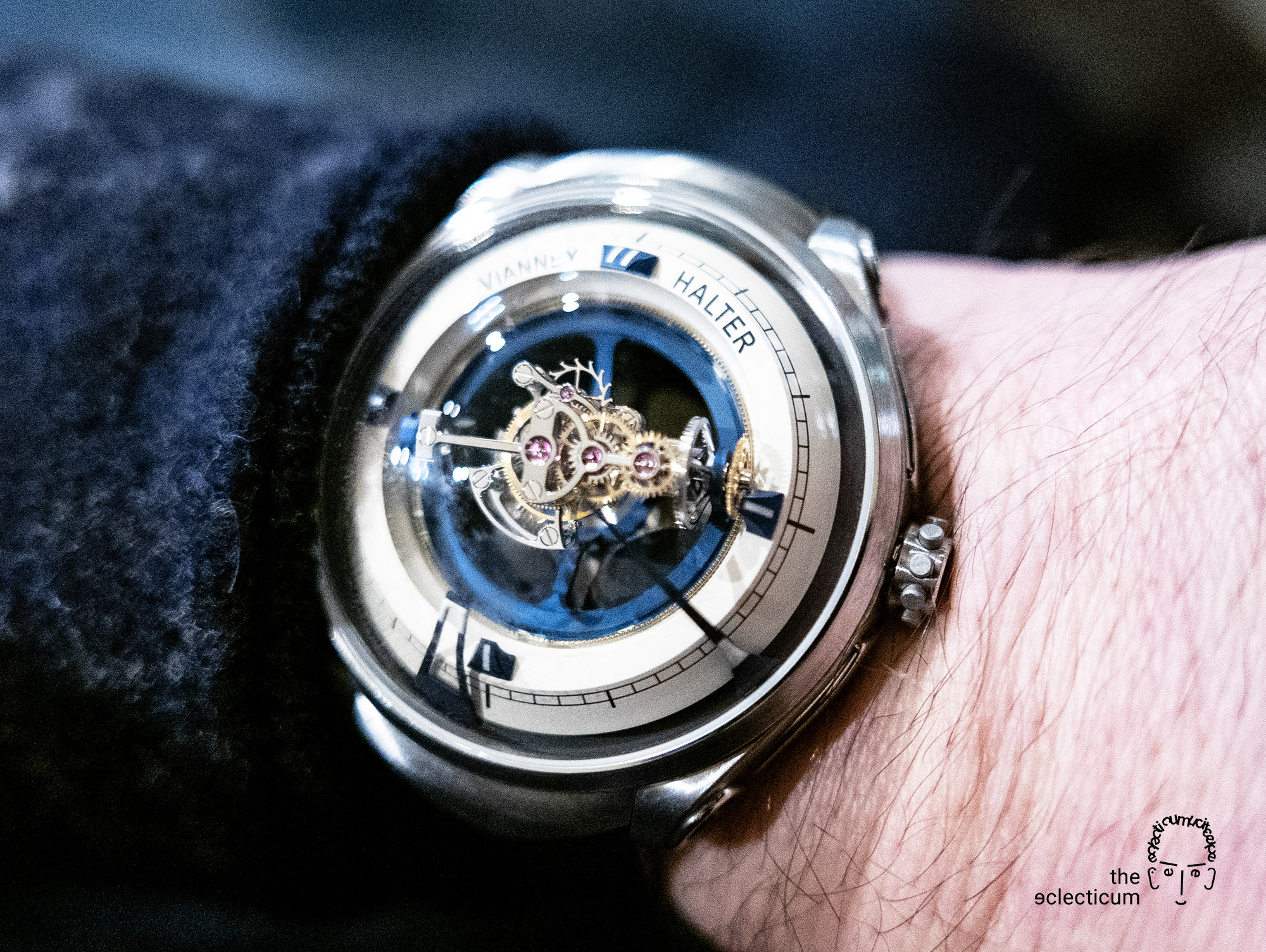
Already with this watch, Halter intended to represent the four coupled dimensions of the universe: length, width and depth – and time.
Now, with the Deep Space Tourbillon Resonance running, he also managed to depict the effect of gravitational waves in shaping their very own universe: through resonance, there is a mutual influence between the dominating forces – and this is different every instance the ‘universe’ is activated (i.e., the watch wound): in terms of relative direction, in terms of resulting frequency. Each time the watch stops and is wound again, the balances ‘negotiate’ de novo, and might conclude to be either in phase or off phase by 180°… just watch the video carefully:
This watch is alive! More – it’s a universe on your wrist and this without any astronomical indication!
In our article on the Janvier Classic (see here!) we concluded that ‘just appreciating a watch is not enough (although the Janvier Classic gives ample reason to do so…) – a watch has an origin and a history. It is the maker with his or her own experiences, interests and personal history.’
Says Vianney Halter:
„When I imagine and build demonstrators like this one, I learn a lot from it. Each mechanical challenge helps me understand our Universe more and more. Every time, I marvel like a child facing it’s complexity and subtlety. What I like the most is understanding, crafting, testing, and in the end sharing. Sharing is the ultimate goal of my work as a watchmaker.“
While the ‘classical’ Vianney Halter watches seem to represent his hobbies and interests, we now have a watch which actually translates recently proven fundamental forces of our universe into a mechanical automaton. With that, the watch transcends its essential definition as a timepiece.

It is difficult for me to put my feelings on this in words, but this is a milestone: Every once in a while, we aficionados witness a moment of horological history, and Vianney Halter has just granted us another such moment with the Deep Space Tourbillon Resonance!
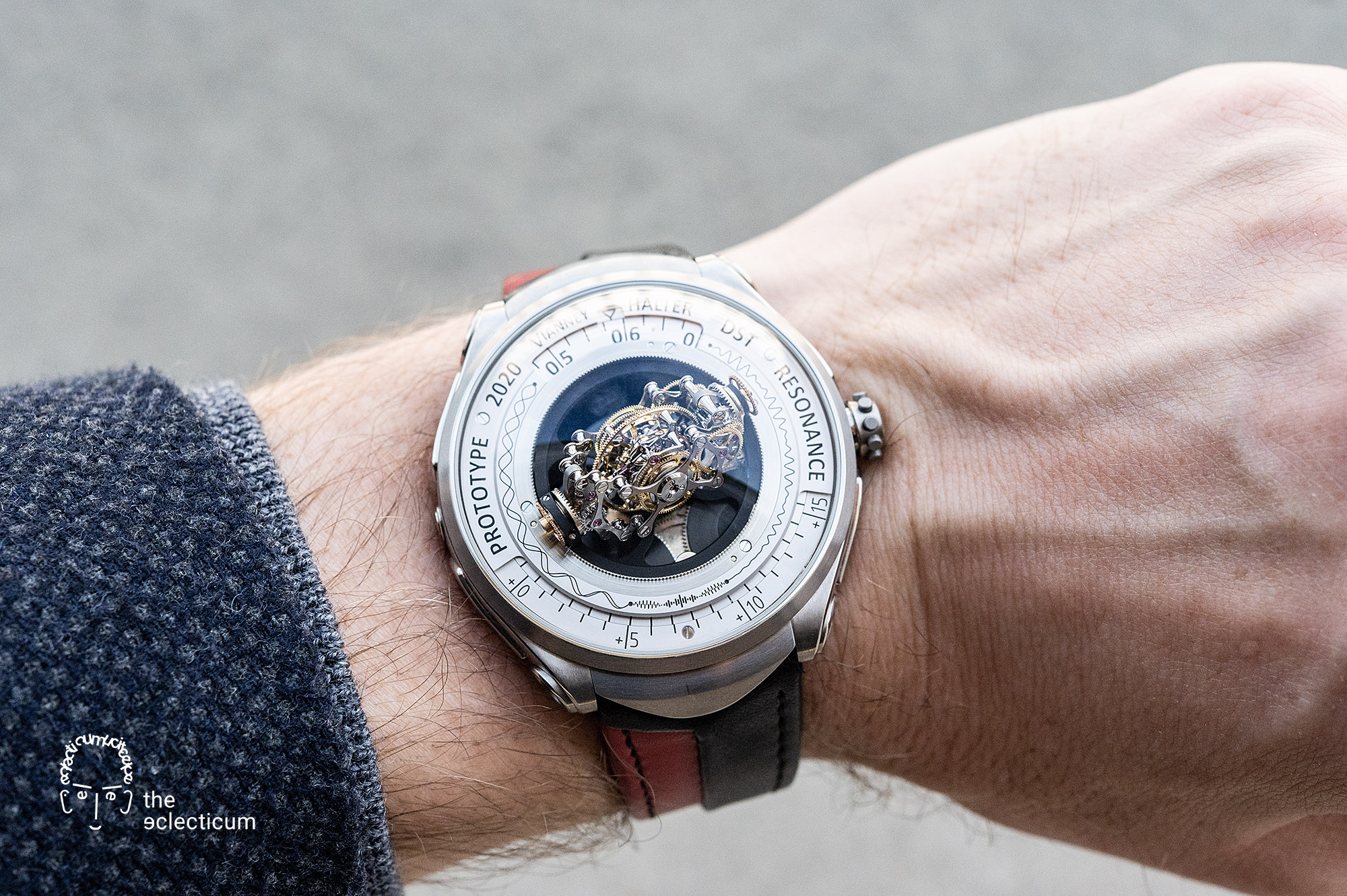
It is as if the Deep Space series of watches have finally found their true expression. I only wish the aesthetics would be more of my liking. In this sense, I miss the good old Halter-Barnes times…
Vianney Halter however was not content here, and just a year later, in 2022, presented a most purist implementation of a reflective resonant wristwatch, called La Resonance:
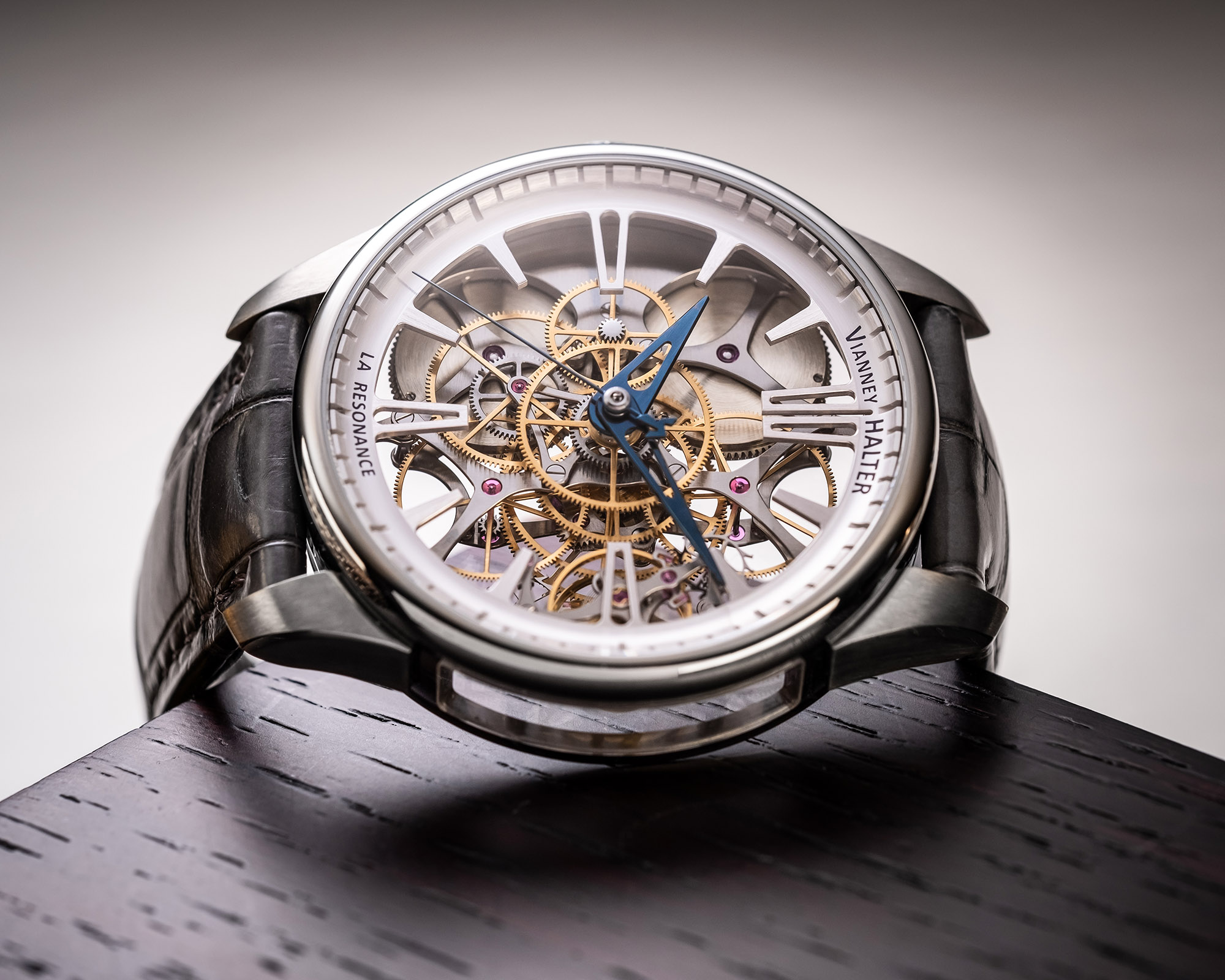 (Vianney Halter La Resonance. Image © TheHorophile)
(Vianney Halter La Resonance. Image © TheHorophile)
Very similarly implemented twin oscillators as in the Deep Space Resonance Tourbillon (stacked), but otherwise reduced to the max, with a light case to match. And this really makes my brain itch as it violates one condition: if, as I outlined above, a certain mass ratio between oscillating organ(s) and the whole movement is required, how can the resonance here occur when the watch is entirely only 35g light, but the balances look very similar to the Deep Space? I might not be understanding the physics behind here completely (or correctly), but the same question actually applies to F.P. Journe’s switch from brass to (denser) gold for the movement plates in this Chronomètre à Résonance…
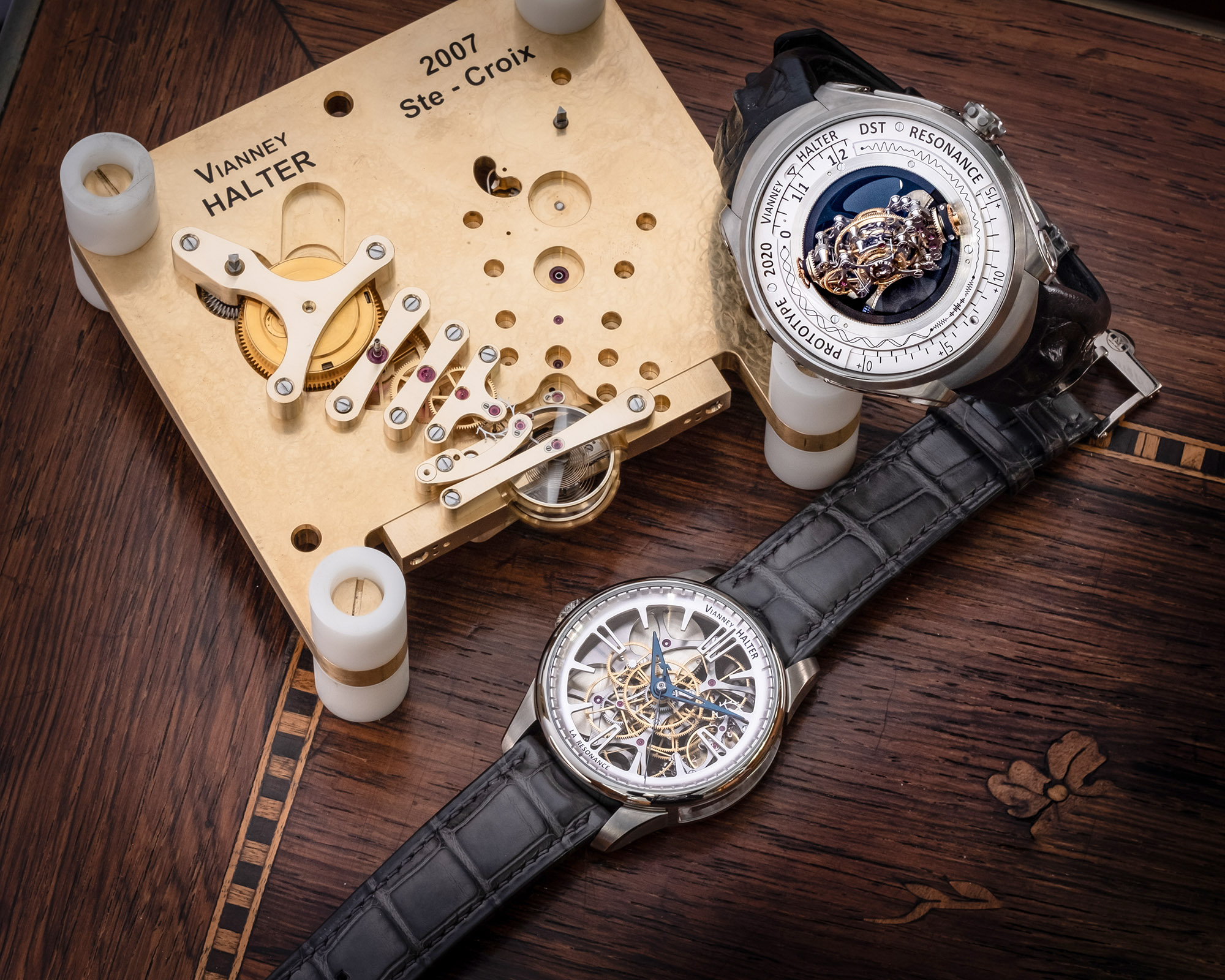
(Clockwise from top left: Vianney Halter’s experimental test-bed, the Deep Space Resonance Tourbillon, La Resonance. Image © TheHorophile)
Fascinating and really, literally mind-blowing stuff! To be revisited…
Ornatus Mundi
______________________________
*) Literature:
I am greatly indebted to a number of authors who let their intellectual curiosity run wild on the topic of resonance. Each of the resources listed below is worth a careful contemplation, as each highlights a different aspect and hence I’d strongly recommend reading all of them, in a tranquil moment:
- Jack Forster, Resonance: Journe, Breguet, And An “Odd Kind Of Sympathy” (Jack Forster’s Substack, 2023) https://jackforster.substack.com/p/resonance-journe-breguet-and-an-odd
- Joshua Munchow, Understanding Resonance (Quill&Pad, 2017) https://quillandpad.com/2017/12/17/understanding-resonance-featuring-f-p-journe-chronometre-resonance-armin-strom-mirrored-force-resonance-haldimann-h2-flying-resonance/
- Justin Koulapis, A Watchmaker’s Technical Look At The Mirrored Force Resonance Fire By Armin Strom (Quill&Pad, 2017) https://quillandpad.com/2017/10/28/watchmakers-technical-look-mirrored-force-resonance-fire-armin-strom-dual-balance-watch-difference/
- Don Corson, Approaching Resonance (WatchProSite, 2013):
